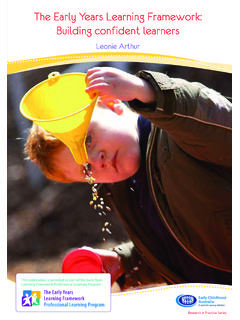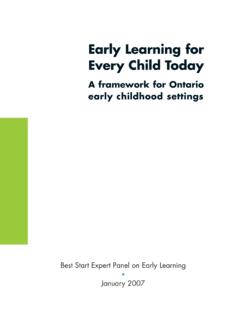Transcription of Supporting Children Learning English as a Second language ...
1 Dr Priscilla Clarke OAM, Early Childhood Consultant Supporting Children Learning English as a Second language in the Early Years (birth to six years) November 2009 This Discussion Paper was commissioned by the VCAA as a Supporting document to the Victorian Early Years Learning and Development Framework, 2009. Victorian Curriculum and Assessment Authority 2009 No part of this publication may be reproduced except as specified under the Copyright Act 1968 or by permission from the VCAA. For more information go to: VCAA provides the only official, up-to-date versions of VCAA publica-tions. Details of updates can be found on the VCAA website: publication may contain copyright material belonging to a third-party. Every effort has been made to contact all copyright owners.
2 If you believe that material in this publication is an infringement of your copyright please email the Copyright Officer c/o: Copyright in materials appearing at any sites linked to this document rests with the author of those materials, subject to the Copyright Act. The VCAA recommends you refer to copyright statements at linked sites before using such materials. ISBN 978-1-921702-17-43Dr Priscilla Clarke, OAM was formally Executive Director of FKA Children s Services, which includes the Multicultural Resource Centre. She is currently an early childhood consultant specialising in the Second language acquisition of young bilingual Children . Priscilla has conducted professional development for early years professionals in Australia, New Zealand, Thailand, England, Scotland, Northern Ireland and Ireland.
3 She is the author of many publications including a book written jointly with Professor Iram Siraj-Blatchford and published by Open University 2003, Dr Clarke was awarded an Order of Australia Medal for her significant contribution to the bilingual preschool education of immigrant and refugee Children Learning English as a Second language in the Early Years (birth to six years) ContentsBackground and purpose 6 Introduction 6 Relationship with the Victorian Early Years Learning and Development Framework (VEYLDF) birth to eight years 7 Who are learners of English as a Second language ? 7 The importance of language for young Children 8 Partnerships with parents 8 The importance of maintaining the first or home language 9 Why is it important to be bilingual?
4 9 Maintaining the first language in Children under three 10 Maintaining the first language in years prior in Children age three to six years 11 Learning English as a Second or an additional language 12 Babies and toddlers 12 Children in the years prior to school 13 Identity and wellbeing 14Do Children need to be fluent in English before going to school? 14 Children new to English in the early years of school 15 Stages of ESL development for Children in the years prior to entering school and the early years of school 16 The importance of oral English language development 16 Stages of Second language acquisition 16 Use of the home language 17 Oral English language development an overview of stages between three to six years of age 17 Stage 1 New to English 17 Stage 2 Becoming familiar with English 19 Stage 3 Becoming a confident user of English 19 Stage 4 Demonstrated competency as a speaker of English 20 Rates of acquisition 22 Provision of inclusive environments 22 Importance of play 22 The role of early childhood professionals 24 Developing listening skills 24 Use of
5 Contextualised language 24 Use of decontextualised language 24 Supporting language comprehension and production 24 Sustained shared communication 25 Assessing outcomes 25 Achieving outcomes 26 language delay 27 Appendix 1 28 Resources and support 28 Books, CDs and resources reflecting diversity of culture and language 29 Reference material for early childhood professionals 29 Appendix 2 30 References and further reading 30 Supporting Children Learning English as a Second language in the Early Years (birth to six years)6 Background and purpose The Victorian Early Years Learning and Development Framework (VEYLDF) (Victorian Framework) birth to eight years, has been developed in partnership with the Office for Children and Portfolio Coordination, Department of Education and Early Childhood De-velopment (DEECD) and the Victorian Curriculum and Assessment Authority (VCAA).
6 The VEYLDF was launched November 2009 for implementation in Victorian Framework describes five Learning and Development Outcomes for Children from birth to eight years. It links the Learning outcomes from the Early Years Learning Framework for Australia to the Victorian Essential Learning Standards (VELS) Lev-els 1 and 2. The Outcomes provide a shared language for all early years childhood professionals and fami-lies to use when planning for Children s Learning and development. This document, Supporting Children Learning English as a Second language in the Early Years (birth to six years) is the first in a series of Implemen-tation guides designed to support families and early years professionals . It has a particular focus on chil-dren in the three to six years age group and supports Children s transition into school.
7 The Victorian Framework recognises that chil-dren s Learning and development takes place in the context of their families and that families are chil-dren s first and most important educators. Families provide Children with the relationships, the opportu-nities and the experiences which shape their Learning and Victorian Framework acknowledges that the families and communities in which Children live are diverse; and that Children s Learning and development is enhanced when they experience relationships with early childhood professionals that respect their cul-ture and ways of knowing and being. In particular the framework recognises and respects Aboriginal and Torres Strait Islander cultures and the unique place of these as a valued part of Victoria s heritage and future.
8 Learning about and valuing the place of first nations people will enhance all Victorian Children s sense of place in our Victorian Framework recognises that every child will take a unique path to the five Learning and Development Outcomes. Children will require dif-ferent levels of support, some requiring significantly more than Australia at the present time there are many chil-dren starting kindergarten or child care for whom English is not their first or home language . Some early childhood settings have a diversity of languages spoken, while others have only one or two Children who do not speak English . Early childhood profes-sionals working with these Children need to ensure that the support they provide benefits all the Children in their program.
9 The five Learning and Development Outcomes in the Victorian Early Years Learning and Development Framework (VEYLDF) birth to eight years are acces-sible to all Children . However, the pathways to these outcomes will vary for different learners. This docu-ment provides information about the Second language Learning development of young Children from birth to six years of age and intersects with the advice of-fered in the Victorian Essential Learning Standards (VELS), English as a Second language (ESL) diversity, respecting and promoting the use of languages other than English and also ensuring all Children acquire English as a Second language , is fundamental to securing the rights of all Children to an early childhood program that meets their needs and provides them with educational and social out-comes that assist them in attaining a high standard of education and a responsible life in the future.
10 Cultural and linguistic diversity has been a fea-ture of Australia for more than 40 000 years. Prior to colonisation currently more than 250 Indigenous lan-guages were spoken throughout Australia. The VEY-LDF recognises family diversity and Children s rights to maintain their culture, language , faith, religion and spirituality. 7 Supporting Children Learning English as a Second language in the Early Years (birth to six years) Relationship with the Victorian Early Years Learning and Development Framework (VEYLDF) birth to eight years The Victorian Framework strengthens Children s Learning and development in the critical years of ear-ly childhood. It identifies what Children should know and be able to do from birth to eight years of age.




